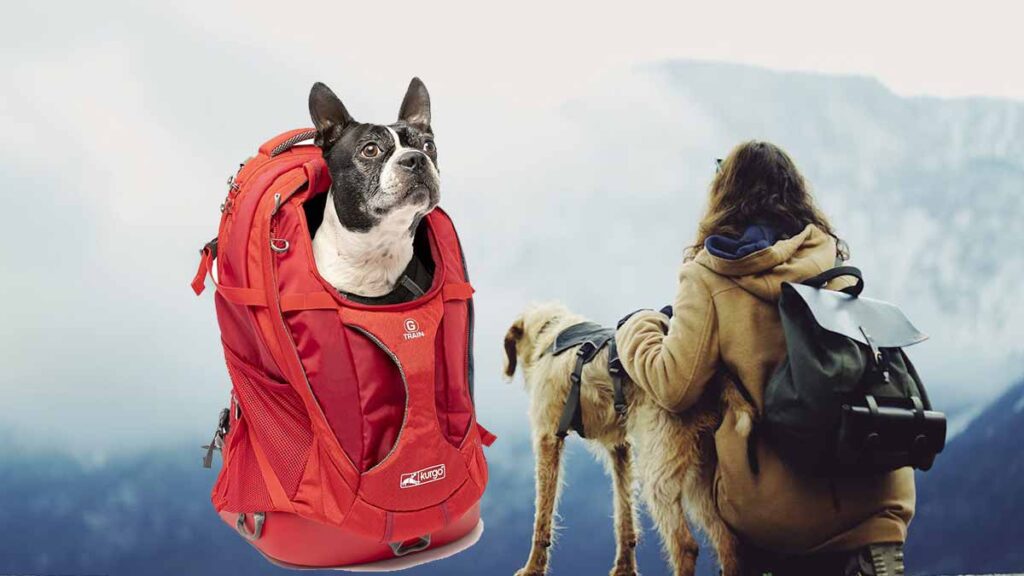Table of Contents
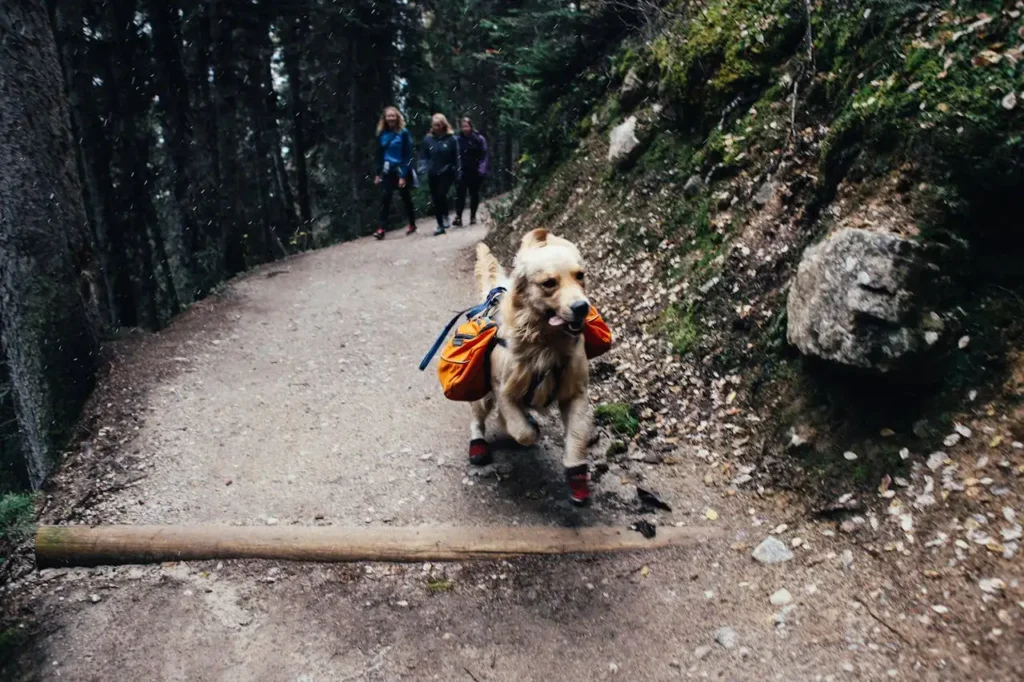
Hitting the trails with your furry best friend by your side is an experience like no other. The fresh air, the scenic views, and the boundless energy of your canine companion make for an unforgettable adventure. However, carrying all the necessary supplies can be a daunting task, weighing you down and potentially dampening the joy of your outdoor excursion.
Enter the dog hiking backpack – a ingenious solution that not only lightens your load but also enhances the overall hiking experience for both you and your four-legged pal. Imagine your beloved pup proudly carrying their own water, treats, and essentials, feeling like a valuable member of the pack and reveling in the sense of purpose that comes with having a “job” to do.
But finding the perfect dog hiking backpack is no easy feat. With an array of options on the market, it’s crucial to consider factors such as comfort, durability, safety features, and overall functionality to ensure your furry friend’s well-being and enjoyment on the trail.
In this comprehensive guide, I’ll delve into the world of dog hiking backpacks, exploring the benefits they offer, the key features to look for, and our top picks to help you make an informed decision. From fitting and training tips to packing essentials and hiking etiquette, I’ve got you covered every step of the way.
So, get ready to embark on a journey that will not only strengthen the bond between you and your canine companion but also create cherished memories that will last a lifetime. Let’s hit the trail together, equipped with the knowledge and gear to make your hiking adventures truly unforgettable.
Why Your Dog Needs a Hiking Backpack
Going on hikes with your furry companion can be an incredibly rewarding experience, but carrying all the necessary supplies can be a hassle. This is where a hiking backpack for your dog comes into play, offering several benefits that make your outdoor adventures more enjoyable for both you and your four-legged friend.
1. Sharing the Load
- A well-fitted dog backpack can help distribute weight evenly across your dog’s body, allowing them to carry their own water, food, and supplies.
- By carrying a portion of the load, your dog can contribute to the hiking experience and feel like a valuable member of the pack.
Here’s a table illustrating the typical items a dog can carry in their backpack:
| Item | Typical Weight |
| Water Bowl | 0.5 – 1 lb |
| Water (for a day) | 1 – 2 lbs |
| Dog Food (for a day) | 0.5 – 1 lb |
| Doggy Bags | Negligible |
| First Aid Kit | 0.5 – 1 lb |
2. Mental and Physical Stimulation
- Carrying a backpack can provide your dog with a sense of purpose and a “job” to do, which is especially beneficial for energetic breeds that thrive on mental stimulation.
- The additional weight and resistance from the backpack can increase the physical exertion during the hike, helping to tire out your furry friend and prevent destructive behavior at home due to pent-up energy.
By allowing your dog to share the load and take on a “job,” a hiking backpack can turn your outdoor adventures into enriching experiences that cater to your dog’s physical and mental well-being.
What are the Features to Look for in a Dog Hiking Backpack
When choosing a hiking backpack for your canine companion, it’s essential to consider several key features to ensure both comfort and safety during your outdoor adventures.
Here are some critical aspects to keep in mind.
1. Comfort and Fit
- Adjustable straps: Look for backpacks with adjustable straps that can be customized to fit your dog’s unique body type and size, ensuring a snug and secure fit.
- Breathable materials: Opt for backpacks made from lightweight, breathable materials like mesh or nylon to prevent overheating and discomfort during physical exertion.
- Ergonomic design: Choose a backpack with an ergonomic shape that contours to your dog’s body, distributing weight evenly and minimizing pressure points.
2. Durability
- High-quality materials: Invest in a backpack made from durable materials like ripstop nylon or heavy-duty canvas, which can withstand rough terrain, brambles, and potential wear and tear.
- Reinforced seams and straps: Look for backpacks with reinforced seams and straps to ensure they can handle the weight of your dog’s supplies without tearing or breaking.
3. Safety Features
- Reflective strips: Backpacks with reflective strips or panels can greatly enhance your dog’s visibility during low-light conditions, ensuring their safety on the trail.
- Bright colors: Opt for backpacks in bright, vibrant colors to make your dog more visible to other hikers and prevent potential accidents.
- Secure leash attachments: Choose a backpack with secure leash attachments, allowing you to easily attach your dog’s leash when necessary.
4. Additional Features (Optional)
- Water-resistant or waterproof material: If you plan on hiking in wet or rainy conditions, consider a backpack made from water-resistant or waterproof materials to protect your dog’s supplies.
- Multiple pockets and compartments: Look for backpacks with multiple compartments and pockets to organize your dog’s food, water, treats, and other essentials.
- Padded back and belly panels: Backpacks with padded back and belly panels can provide additional cushioning and comfort for your dog during long hikes.
By considering these features, you can ensure that your dog’s hiking backpack not only helps carry the load but also prioritizes their comfort, safety, and overall enjoyment on the trail.
Top 5 Picks for Dog Hiking Backpacks
When it comes to choosing the perfect hiking backpack for your furry companion, there are several factors to consider, such as comfort, durability, and functionality. Here are our top five picks for dog hiking backpacks, along with their key features, pros, cons, and affiliate links to help you make an informed decision.
1. Ruffwear Palisades Pack

Key Features
- Designed for multi-day hikes and backcountry adventures
- Removable saddlebags for easy loading and unloading
- Integrated harness system for a secure fit
- Radiant reflective trim for low-light visibility
Pros
- Excellent weight distribution for your dog’s comfort
- Durable and water-resistant materials
- Customizable fit with adjustable straps
Cons
- More expensive than some other options
- May be too bulky for shorter hikes
2. EzyDog Summit Pack
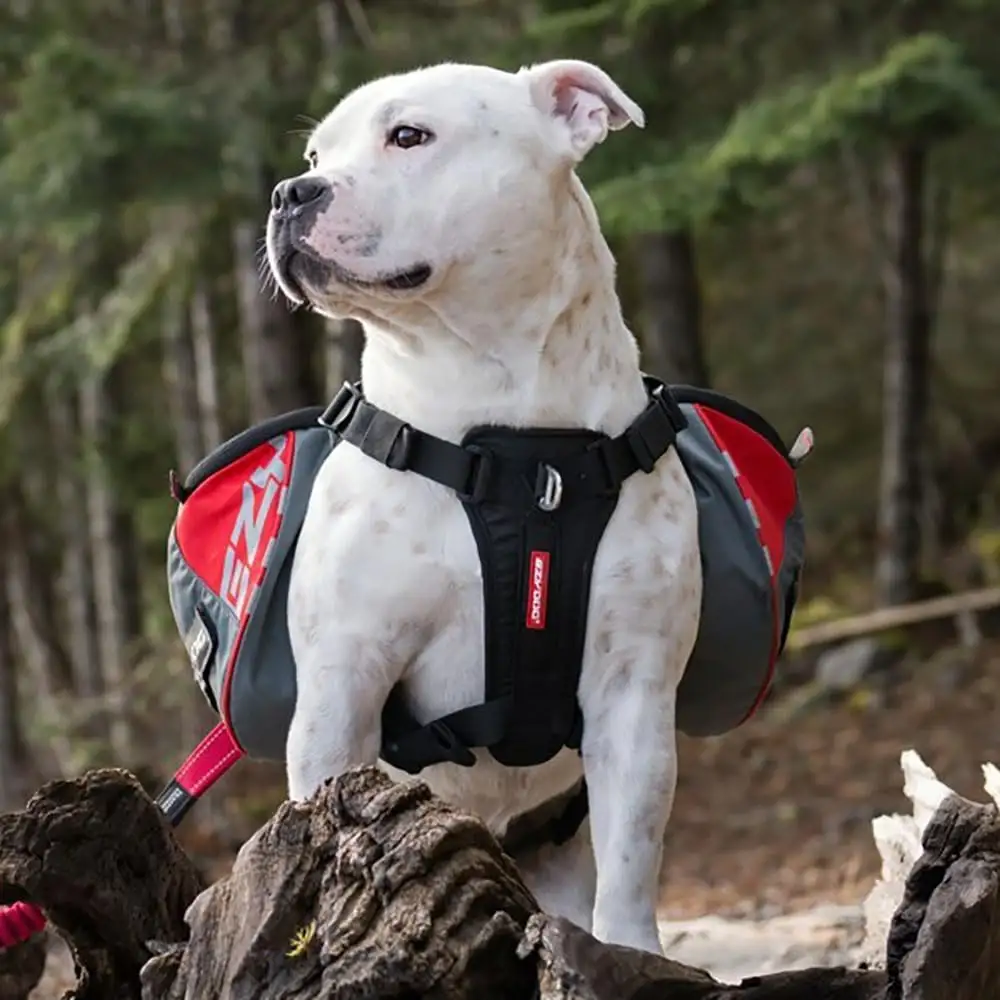
Key Features
- Incorporates the award-winning EzyDog chest-plate harness
- Padded back and belly panels for extra comfort
- Water-resistant materials and pockets
- Reflective trim for visibility
Pros
- Comfortable and secure fit
- Easy access to pockets and compartments
- Affordable price point
Cons
- Limited color options
- Capacity may be limited for longer hikes
3. Ruffwear Singletrak Pack
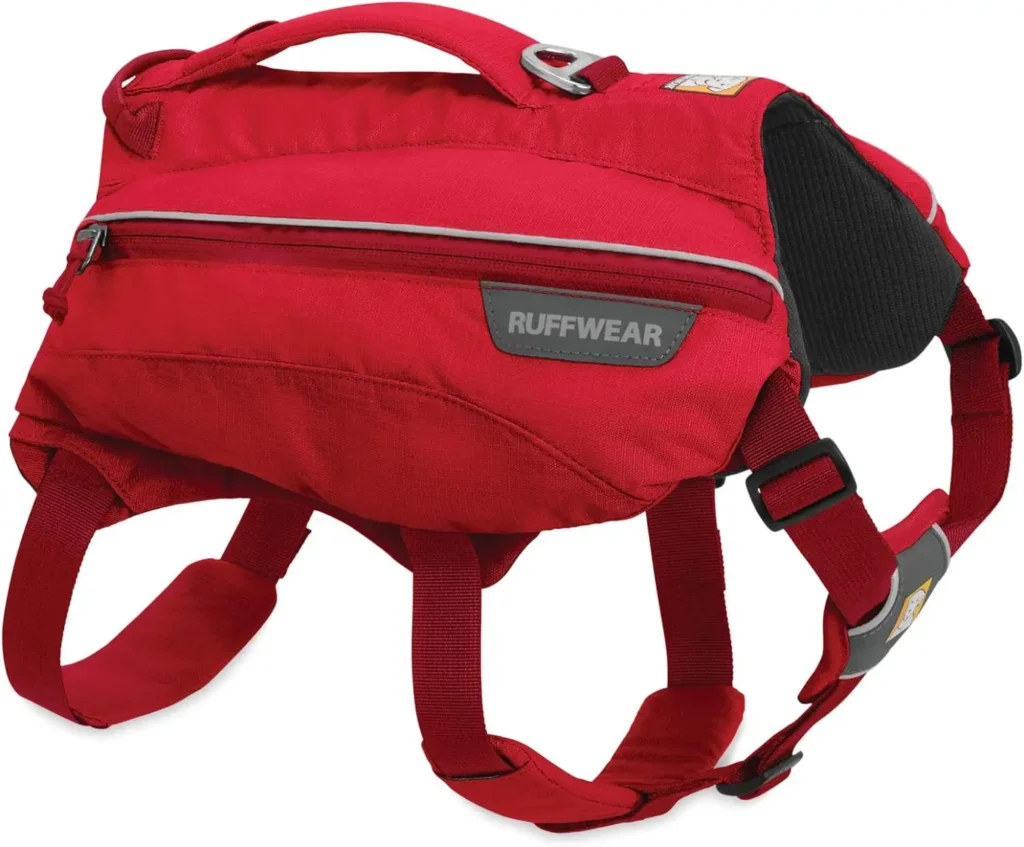
Key Features
- Low-profile design for day hikes and trail runs
- Integrated hydration system with a 1-liter water bladder
- Secure leash attachment point
- Reflective trim for visibility
Pros
- Lightweight and minimalist design
- Convenient hydration system for your dog
- Durable and weather-resistant materials
Cons
- Limited capacity for carrying additional gear
- May not be suitable for larger dogs
4. Outward Hound DayPak
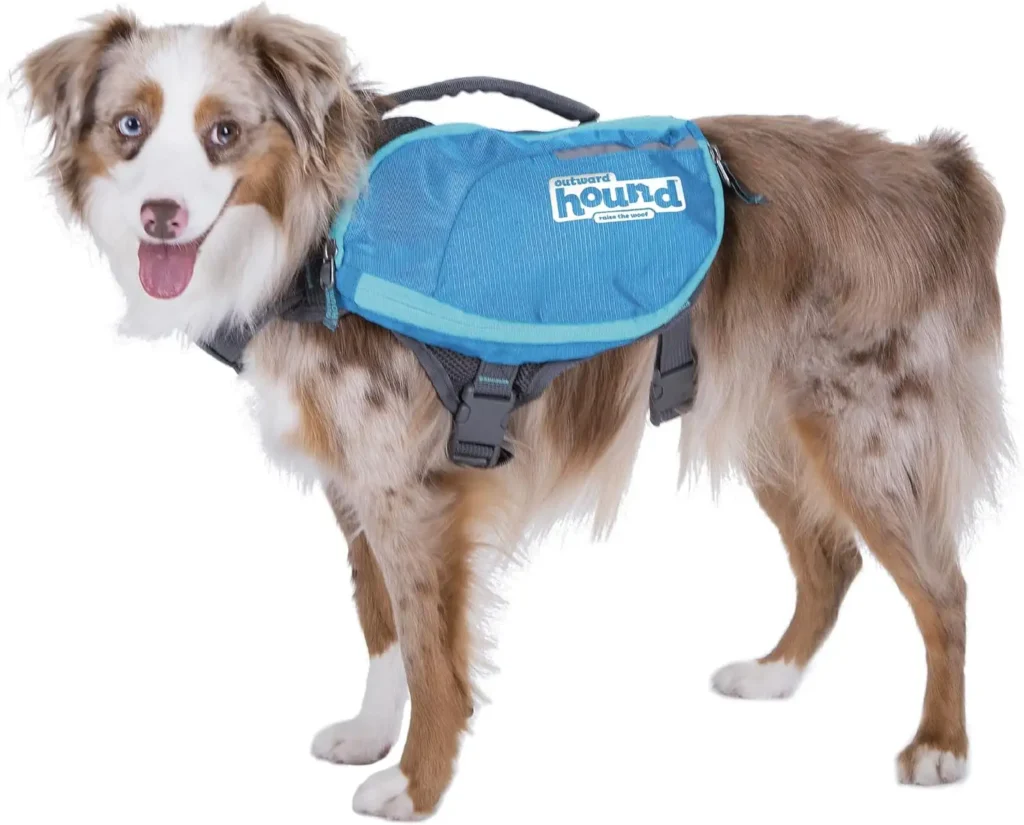
Key Features
- Spacious main compartment for carrying supplies
- Mesh-lined pockets for ventilation
- Adjustable straps for a customized fit
- Reflective accents for visibility
Pros
- Affordable price point
- Easy to adjust and fit
- Multiple pockets and compartments
Cons
- Limited durability compared to higher-end options
- Lacks specialized features like hydration systems
5. Kurgo Dog Backpack
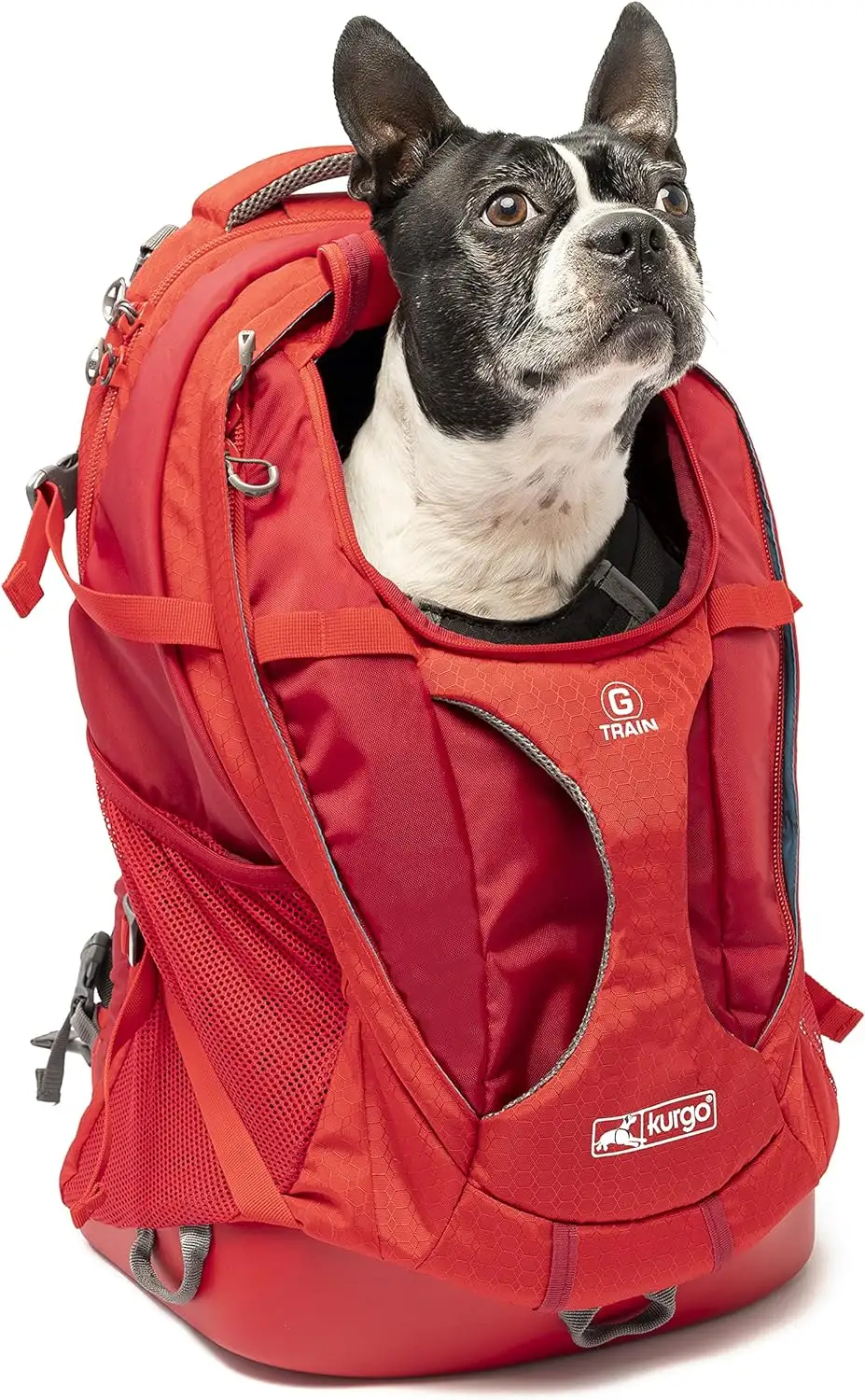
Key Features
- Lightweight and breathable mesh construction
- Water-resistant material and pockets
- Adjustable straps for a customized fit
- Reflective trim and bright colors for visibility
Pros
- Budget-friendly option
- Comfortable and well-ventilated design
- Compact and easy to pack
Cons
- Limited capacity for longer hikes
- May not be as durable as some higher-end options
To get your hands on any of these top dog hiking backpacks, simply click on the affiliate link provided for the product of your choice. This will take you directly to the retailer’s website, where you can purchase the backpack and enjoy the convenience of having it delivered right to your doorstep.
Remember, when selecting a dog hiking backpack, consider your furry friend’s size, weight, and activity level, as well as the type of terrain and duration of your hikes. With the right backpack, you and your canine companion can embark on unforgettable outdoor adventures together.
How to Fit and Train Your Dog to Wear a Backpack
Introducing your furry friend to a hiking backpack is a gradual process that requires patience and proper training. By following a step-by-step fitting guide and incorporating positive reinforcement techniques, you can ensure your dog’s comfort and safety while wearing their backpack on the trail.
Step-by-Step Fitting Guide
Step 1: Measure Your Dog
Accurately measure your dog’s chest and back length to ensure you purchase the correct backpack size.
Step 2: Adjust the Straps
With your dog standing, place the backpack on their back and adjust the straps to achieve a snug but comfortable fit. The backpack should sit evenly without restricting movement.
Step 3: Check for Comfort
Once the straps are adjusted, ensure the backpack doesn’t rub against your dog’s skin or cause any discomfort. You should be able to slide two fingers between the backpack and your dog’s body.
Step 4: Secure the Belly Strap
If your backpack has a belly strap, secure it loosely to prevent the backpack from shifting during movement.
Step 5: Test the Fit
Allow your dog to walk around and observe their movement, adjusting the straps as needed to achieve the perfect fit.
Training Tips
- Start slow: Begin by letting your dog wear an empty backpack around the house for short periods, gradually increasing the duration.
- Use positive reinforcement: Offer treats and praise when your dog remains calm and relaxed while wearing the backpack.
- Add weight gradually: Once your dog is comfortable with the empty backpack, start adding small weights (e.g., water bottles) and increase the load over time.
- Practice on short walks: Incorporate short walks with the backpack to help your dog adjust to the added weight and movement.
- Build endurance: Slowly increase the duration and distance of your walks, allowing your dog to build endurance while wearing the backpack.
- Maintain a positive association: Always end training sessions on a positive note, ensuring your dog associates the backpack with a rewarding experience.
Here’s a suggested training timeline.
| Week | Duration | Load |
| 1 | 10-15 minutes | Empty backpack |
| 2 | 20-30 minutes | 1-2 lbs |
| 3 | 30-45 minutes | 2-4 lbs |
| 4+ | 1 hour+ | Up to 25% of dog’s weight |
Remember, every dog is unique, and some may progress faster or slower than others. Patience and positive reinforcement are key to successfully introducing your furry companion to a hiking backpack.
What are the Packing Essentials for Your Dog’s Hiking Backpack
Once you’ve found the perfect hiking backpack for your canine companion, it’s time to pack it with the essential items they’ll need on the trail. To ensure your dog stays safe, hydrated, and comfortable during your outdoor adventures, consider including the following packing essentials:
1. Water and Collapsible Bowl
- Pack enough water for your dog to stay hydrated throughout the hike.
- Consider investing in a collapsible water bowl that takes up minimal space in the backpack.
2. Snacks and Treats
- Pack your dog’s favorite treats or nutrient-dense snacks to keep their energy levels up during the hike.
- Choose treats that are easy to carry and won’t crumble or melt in the backpack.
3. Waste Bags
- Bring plenty of waste bags to clean up after your furry friend on the trail.
- Opt for biodegradable or compostable bags to minimize environmental impact.
4. First-Aid Kit
- Assemble a basic first-aid kit tailored to your dog’s needs, including bandages, gauze, antiseptic wipes, and any necessary medications.
5. Insulated Pack
- If you plan to carry perishable items like wet food or ice packs, consider investing in an insulated pack or a small cooler to keep them fresh.
6. Paw Protection (Optional)
- For rough terrain or hot surfaces, you may want to pack dog booties or paw wax to protect your dog’s paws from potential injuries or burns.
7. Extra Leash or Harness (Optional)
- Carrying an extra leash or harness can be a lifesaver if your dog’s primary gear gets lost or damaged during the hike.
By packing these essentials in your dog’s hiking backpack, you’ll be prepared for any situation that may arise on the trail, ensuring a safe and enjoyable adventure for both you and your furry companion.
Safety and Etiquette While Hiking with Your Dog
Hiking with your beloved canine companion can be an incredibly rewarding experience, but it’s crucial to prioritize safety and etiquette to ensure an enjoyable outing for all. By following these essential guidelines, you can create a positive and responsible hiking experience for you, your dog, and fellow trail users.
Safety Tips
1. Leash Compliance
- Always follow leash rules and regulations on the trails you visit.
- Keep your dog leashed in areas where it’s required, such as near wildlife habitats or on crowded trails.
- Consider using a hands-free leash or waist leash for better control and freedom of movement.
2. Monitor Your Dog’s Condition:
- Watch for signs of fatigue, overheating, or paw injuries, and be prepared to adjust your hiking pace or distance accordingly.
- Provide plenty of water breaks and rest stops to prevent dehydration and exhaustion.
- Check your dog’s paws regularly for cuts, abrasions, or debris that could cause discomfort.
3. Be Prepared
- Carry a basic first-aid kit, including supplies specific to your dog’s needs (e.g., bandages, antiseptic wipes, gauze pads).
- Pack extra water and snacks in case your hike takes longer than anticipated.
- Consider investing in a dog-specific hiking backpack to help your furry friend carry their own supplies.
Etiquette Tips
1. Respect Trail Rules and Regulations
- Familiarize yourself with the rules and regulations of the trails you plan to hike.
- Adhere to any specific guidelines for dogs, such as on-leash requirements or restricted areas.
2. Leave No Trace
- Always clean up after your dog by properly disposing of waste in designated areas or carrying it out with you.
- Avoid letting your dog disturb or damage vegetation, wildlife habitats, or archaeological sites along the trail.
3. Yield to Others
- When encountering other hikers, runners, or cyclists on the trail, step aside and keep your dog under control to allow them to pass safely.
- Be mindful of other trail users who may be fearful or allergic to dogs, and give them ample space if requested.
4. Control Barking and Noise
- Keep your dog’s barking and noise to a minimum to avoid disturbing other hikers or wildlife.
- Consider using positive reinforcement training techniques to encourage quiet behavior on the trail.
By following these safety and etiquette guidelines, you can ensure a memorable and enjoyable hiking experience for you, your four-legged friend, and fellow outdoor enthusiasts.
Conclusion
Embarking on hiking adventures with your furry companion is an enriching experience that fosters a deeper bond and creates cherished memories. By investing in a high-quality dog hiking backpack, you can elevate these outdoor excursions, ensuring both you and your canine friend enjoy a comfortable, safe, and rewarding journey. Here are the key takeaways to remember:
- A well-designed dog hiking backpack allows your pup to contribute to the hike by carrying their own supplies, fostering a sense of purpose and accomplishment.
- Choosing a backpack with adjustable straps, breathable materials, and an ergonomic design ensures a comfortable and secure fit, preventing chafing or discomfort.
- Safety features like reflective strips, bright colors, and secure leash attachments enhance visibility and control, giving you peace of mind on the trail.
- Durable and weather-resistant construction ensures your dog’s backpack can withstand the rigors of outdoor adventures, providing long-lasting performance.
- Packing the essential items, such as water, snacks, waste bags, and a first-aid kit, ensures you’re prepared for any situation that may arise during your hike.
As you plan your next hiking adventure, consider investing in one of the top-rated dog hiking backpacks featured in this article. From the rugged Ruffwear Palisades Pack to the budget-friendly Kurgo Dog Backpack, these products have been carefully selected to cater to various needs and preferences.
To explore these options further and make your purchase, simply click on the affiliate links provided. Not only will you receive a high-quality product, but you’ll also benefit from the convenience of having it delivered directly to your doorstep.
Remember, investing in the right gear can significantly enhance the hiking experience for both you and your furry friend. So, embrace the call of the great outdoors and embark on unforgettable adventures with your beloved canine companion by your side, equipped with the perfect dog hiking backpack.
FAQ
Are dog backpacks OK for dogs?
Yes, dog backpacks are generally safe and beneficial for dogs when used correctly. They allow dogs to carry their own supplies, provide mental stimulation, and distribute weight evenly across their body.
How long can a dog stay in a backpack?
Dog backpacks are designed for hiking and outdoor activities, not for extended periods of confinement. Dogs should only wear backpacks during active outings and be given frequent breaks to rest and hydrate.
How much can dogs carry hiking?
The amount a dog can carry while hiking depends on their size, breed, and fitness level. As a general guideline, dogs should carry no more than 25% of their body weight in their backpack.
Can I bike with my dog in a backpack?
While dog backpacks are designed for hiking, they are not suitable for biking. The motion and balance required for cycling could cause discomfort or injury to your dog. It’s best to use a designated dog carrier or trailer when biking with your furry friend.


